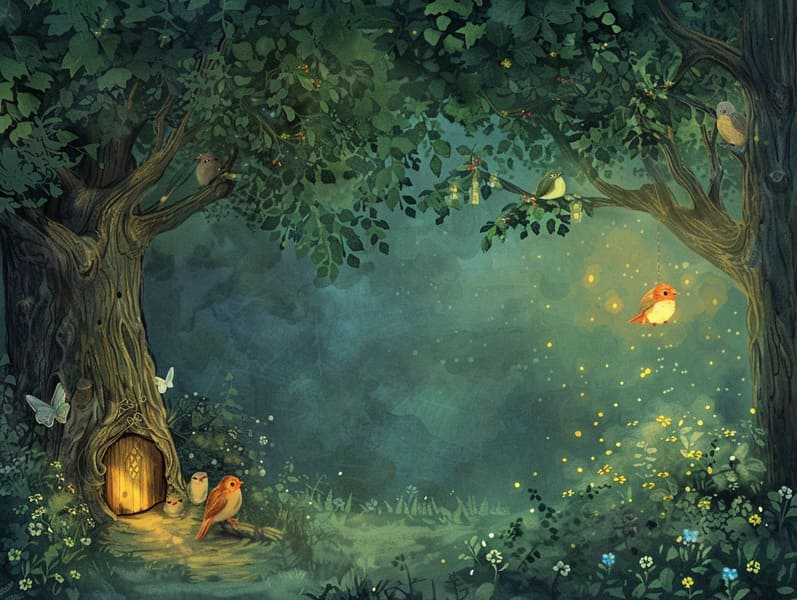
Traditional fairy tales have enduring presence. These narratives have been shared from one generation to the next centuries before they were ever recorded. They developed from a variety of backgrounds, including Asian traditions. They were initially conveyed among mature audiences, often carrying themes and messages relevant to the societal norms and beliefs of the time.
The Grimm brothers, Jacob and Wilhelm, were among the first to compile and publish many of these beloved tales. Their anthology, "Grimm's Fables," included stories like "The True Bride," "The Story of Hansel and Gretel," and "Little Snow White," which have since become cornerstones in the world of timeless fairy tales. Similarly, Hans Christian Andersen's fanciful fairy tales, such as "The Little Mermaid," and "The Story of the Ugly Duckling," have won hearts worldwide, cementing their place in the pantheon of classic fairy tales.
Despite being ancient, traditional fairy tales remain as significant as ever, especially as nighttime stories for kids. These charming stories are now available in diverse formats, including colorful picture books, magical animations, and internet fairy tales.
Their ongoing significance can be connected to several fascinating points:
Moral Lessons: Timeless fairy tales often impart important moral lessons. Tales like "The Boy Who Cried Wolf" teach the value of being truthful, while "The Hare and the Tortoise" illustrate the qualities of tenacity and unpretentiousness. These tales offer children clear distinctions between moral and immoral, helping to shape their moral compass in a kind yet significant way.
Compassion and Insight: Fairy tales frequently include characters facing obstacles and hardships, fostering young listeners to identify with their struggles and celebrate their triumphs. For instance, "Beauty and the Beast" highlights the virtue of seeing beyond the surface to comprehend the true character of a being, encouraging kindness and knowledge.
Cultural Recognition: Many old fairy tales are interwoven with the cultural contexts from which they came. Exploring these stories can provide delightful insights into different backgrounds, developing a sense of international awareness and understanding.
Creativity and Imagination: The fanciful elements in timeless fairy tales—magic wands—revitalize children’s dreams. These narratives guide readers to enchanted realms, triggering fantastical thinking and a sense of awe that lasts a lifetime.
Ancient fairy tales are not only charming but also informative. They work as bewitching tools in advancing various brain and heart skills in little ones. When old fairy tales are read aloud, they promote speech development by bringing new language and sophisticated sentence structures. This practice also develops listening abilities and concentration, as the young listen intently, prepared to see what happens next.
Furthermore, conversing about the themes and characters of traditional fairy tales can foster analytical skills and thinking skills. Kids are instructed to see patterns, guess what will happen, and grasp cause and effect. These discussions also assist the young voice their thoughts and feelings, cultivating their emotional intelligence.
In today’s digital era, the abundance of internet fairy tales has made these fairy tales more attainable than ever. Web platforms and applications extend vast collections of old fairy tales that can be enjoyed or listened on anytime, anywhere. Fairy tales voiced are particularly common, presenting an fun way for little ones to relish these charming stories. Narrated books and read-out-loud stories bring characters and settings to life, often supplemented by mesmerizing background sounds and songs that boost the tale experience.
The lasting appeal of old fairy tales lies in their ability to transform to current eras while sustaining their central values. Contemporary revisions of these tales often show more representative characters and modern settings, making them pertinent to today’s audience. However, the core values of bravery, understanding, and truth remain unchanged, continuing to connect with young listeners of all ages.
Old fairy tales also offer a sense of coziness and comprehensibility. They highlight a structured narrative with a obvious beginning, middle, and end, often drawing to a close with the closure of conflicts and the triumph of honesty over deceit. This certainty can be heartening for kids, furnishing a sense of constancy in an variable world.
Ancient fairy tales continue to mesmerize and coach new generations, maintaining their radiance and importance in modern society. As kids' bedtime tales, they introduce a perfect blend of magic and knowledge, developing moral values, empathy, and creativity. The availability of digital storybooks and the popularity of fairy tales recited confirm that these classic fairy tales remain within reach to new generations.
By upholding and imparting these fairy tales, we continue to commemorate the rich tapestry of cultural legacy and cultural heritage. Whether you are seeing a colorful picture book, experiencing a virtual library, or playing an narrated book, the wonder of popular fairy tales is always within reach. These tales demonstrate of the continued impact of narratives and its ability to gather us across centuries and lands.
Even if you are accessing a beautifully read more illustrated book, seeing a internet library, or hearing an spoken story, the fascination of children's fairy tales is always within reach.
These narratives demonstrate of the persistent influence of narratives and its ability to draw us together across epochs and places, casting a charm that delights and instructs alike.